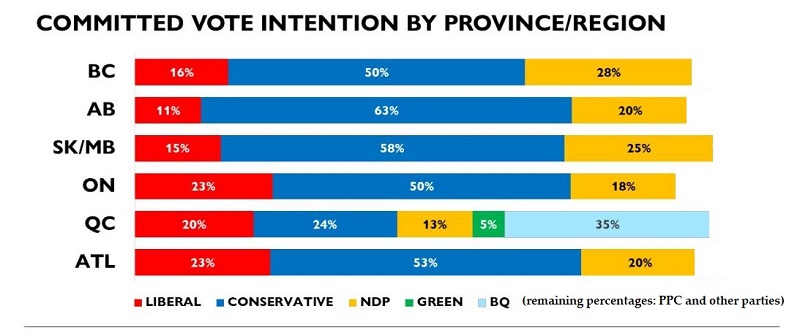Conservatives-Liberals, the gap is huge
TORONTO – The Liberals’ moves to try to regain credibility among the Canadian electorate are in vain: the gap with the Conservatives remains abysmal. The latest poll that certifies this is the one conducted by Abacus from January 9 to 14 on a sample of 1,500 Canadian adults. Let’s look at some data, as reported by Abacus.
“If an election were held today, 46% of committed voters would cast a ballot for the Conservatives, 20% would vote Liberal, and 19% would support the NDP. The Bloc Québécois sits at 8% nationally, while the Greens are at 4% and the People’s Party at 3%, with no measurable support going to other parties.”
“Compared to our last update (January 9), the Conservative vote share has dipped by 1 point, while Liberal support remains unchanged. The NDP has edged up by 1 point, and the Greens have also inched upward by 1 point. Despite the slight decline, the Conservatives continue to hold a substantial lead—26 points ahead of the Liberals.”
“Among those most certain to vote, the Conservative advantage grows: support for the Conservatives increases to 49%, the Liberals drop to 18%, and the NDP sits at 20%, reflecting a 3-point boost for the Conservatives and a 2-point turnout suppression for the Liberals relative to the overall committed voter pool. BQ support among these likely voters reaches 10%, the Greens hold at 3%, the People’s Party stands at 2%, and less than 1% indicate support for another party.”
Regionally, the Conservatives lead in every province except Quebec, where the B.Q. is well ahead of the second-place Conservatives and third-place Liberals. In Ontario, 50 per cent of adults would vote Conservative, with the Liberals at 23 per cent and the NDP at 18 per cent. And that’s not even the best showing for Pierre Poilievre’s party, which would hit 58 per cent in Saskatchewan and Manitoba and a whopping 63 per cent in Conservative Premier Danielle Smith’s Alberta (see the graphic above in the page).
The Conservatives hold a clear lead among all age groups, though the degree of that lead varies. Among younger Canadians aged 18 to 29, 43% would vote Conservative, 21% Liberal, and 22% NDP, with smaller shares for the Greens (6%), Bloc Québécois (4%), and People’s Party (4%). But if you move up to the age group between 45 and 59, Conservative support climbs to 49%, while 15% back the Liberals and 22% support the NDP. The BQ stands at 9%, the Greens at 3%, and the People’s Party at 3% in this age group.
As for gender distinction, Abacus explains, “the Conservatives continue to lead among both men and women, though the size of that lead varies by gender. Among men, 51% say they would vote Conservative, while 17% would support the Liberals, and 16% back the NDP. Another 9% would vote Bloc Québécois, 4% for the Greens, and 3% for the People’s Party. Among women, 42% indicate they would vote Conservative, followed by a tie between the Liberals and the NDP at 23% each. Support for the Bloc Québécois stands at 6% among women, with 4% opting for the Greens and 2% for the People’s Party.”
The poll also takes into account other factors, including education level, but the Conservatives’ lead remains very large across all age groups (to see the full poll, click here).
Finally, the poll shows that Canadians continue to have overwhelmingly negative opinions of Justin Trudeau (only one in five Canadians say they have a positive impression of him, while about 64% express a negative opinion: the announcement of his resignation as Liberal leader has served little purpose) and also of Jagmeet Singh, leader of the NDP, who is liked by only 29% of Canadians while 42% have a negative opinion of him. It must be said that Conservative leader Pierre Poilievre is not doing very well either: about 41% of Canadians have a positive impression of him, but 40% have a negative impression: and yet, if the vote were held now, his party would win the election by a landslide. As if it were, for many Canadians, the lesser evil.



